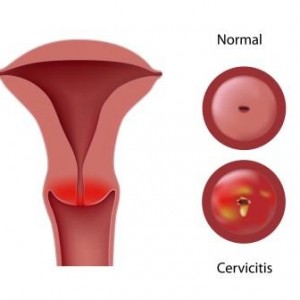
Friable Cervix or Cervicitis Treatment with a Toronto Naturopath
What is a friable cervix?
The cervix is the small tunnel that leads from your vagina into your uterus. A friable cervix is easily irritated and inflamed and can bleed, particularly after intercourse. When performing a PAP smear, your MD or gynecologist may notice bleeding from your cervix or inflammation.
Other causes of abnormal bleeding need to be ruled out, such as complications of pregnancy, malignant tumours (endometrial, cervical, vaginal, vulvar, and ovarian), infection (endometritis, salpingitis, chlamydia), and other benign pelvic disorders (traumatic lesions of the vagina, severe vaginal infections, foreign bodies, cervical polyps, submucous uterine leiomyomas, adenomyosis, endometriosis, and endometrial polyps).
Causes of medically induced abnormal uterine bleeding include hormones and birth control pills, digitalis, phenytoin, anticoagulants, and IUDs. Systemic diseases that may cause abnormal uterine bleeding include hypothyroidism, cirrhosis, and coagulation disorders.
What can be done to heal a friable cervix?
Conventional treatment may involve antibiotics or antifungals to address underlying infections, and in some cases, silver nitrate or other cauterizing agents may be applied to seal fragile blood vessels and reduce spotting. While these treatments can help manage symptoms, they do not always resolve the underlying reason the cervix has become inflamed or irritated.
From a naturopathic perspective, treatment focuses on identifying and addressing the root cause of cervical inflammation. This may include assessing for chronic infections, imbalances in vaginal flora, hormonal fluctuations (such as low estrogen or elevated progesterone), or irritation from products like lubricants, spermicides, or even certain menstrual products. Supporting cervical and vaginal tissue healing often involves optimizing the local microbiome, improving immune function, reducing systemic inflammation through diet and lifestyle changes, and restoring hormonal balance when needed. Nutritional and herbal therapies that support tissue repair, such as vitamin C, zinc, calendula, or probiotic suppositories, may also be used to encourage healthy cervical tissue regeneration and prevent recurrence.
Possible causes of inflammation of the cervix:
Sexually Transmitted Diseases (STDs) and Friable Cervix:
STDs like HPV virus, Gonorrhea, herpes virus and Chlamydia. Boosting the immune system, taking anti-microbial herbs, and strengthening the tissue that lines the cervix can help fend off STDs and defeat viruses like the herpes virus and HPV virus.
Vaginal dysbiosis and a friable cervix
Dysbiosis refers to an imbalance in the vaginal microbiome, specifically, an overgrowth of potentially harmful bacteria or yeast combined with a reduction in beneficial Lactobacillus species that normally help maintain an acidic, protective environment. This imbalance can develop after antibiotic use, which wipes out both harmful and beneficial microorganisms, or from hormonal changes, stress, immune suppression, or exposure to irritating products such as scented washes or lubricants.
When the vaginal flora shifts toward a state of dysbiosis, conditions such as bacterial vaginosis, yeast infections, or colonization with other unwanted microorganisms can occur. These pathogens can release toxins and inflammatory compounds that irritate the delicate cervical tissue, leading to chronic inflammation. Over time, this ongoing irritation can make the cervix more fragile, resulting in a “friable” cervix that bleeds easily after intercourse, Pap tests, or even mild contact.
Restoring a healthy vaginal microbiome is therefore an essential part of treatment. This may involve addressing any active infections, re-establishing healthy Lactobacillus populations through oral or vaginal probiotics, supporting mucosal immunity, and identifying underlying factors—such as blood sugar imbalance, hormonal shifts, or nutrient deficiencies—that allow dysbiosis to persist.
Food sensitivities and Friable Cervix
Most people have several mild food allergies or sensitivities that can contribute to inflammation anywhere in the body, including the bladder, vagina, sinuses, digestive tract, and cervix. Symptoms of these include bloating, gas, constipation, diarrhea, fullness after eating, heartburn, headaches, sinus problems, skin rashes, tiredness, muscle weakness, joint pain, eczema, acne, psoriasis, rosacea, environmental allergies, asthma, etc, basically anything that involves inflammation.
Reduced ability to produce your own “anti-inflammatories” and a friable cervix
Your body has a built-in system for controlling inflammation. It naturally produces anti-inflammatory compounds—such as certain prostaglandins and corticosteroids—that help resolve tissue irritation and promote healing. These substances act like your body’s own internal “anti-inflammatory medicine,” keeping inflammation balanced so that tissues can repair properly rather than remain irritated.
However, when this system isn’t functioning optimally, inflammation can linger and affect sensitive tissues like the cervix. A common reason for this imbalance is a deficiency of omega-3 fatty acids (found in foods like wild-caught fish, flax, and chia), which are essential for producing anti-inflammatory prostaglandins. At the same time, an excessive intake of inflammatory fats—such as processed seed oils and trans fats—can tilt the balance toward pro-inflammatory prostaglandin production.
In addition, the adrenal glands play a critical role in inflammation control because they produce cortisol, one of the body’s main natural corticosteroids. When adrenal function is weakened by chronic stress, fatigue, or nutrient depletion, cortisol production can decline, reducing your body’s ability to regulate inflammation effectively. This can contribute to persistent low-grade inflammation in cervical and vaginal tissues, making the cervix more prone to fragility and bleeding.
Supporting healthy inflammation balance involves restoring the nutritional building blocks needed for anti-inflammatory prostaglandins, optimizing adrenal resilience through stress management and adequate sleep, and ensuring overall hormonal and nutrient balance. By helping the body regain its natural anti-inflammatory capacity, cervical tissue can heal more effectively and regain normal tone and resilience.
Poorly regulated blood sugar levels, higher insulin, and a friable cervix
Blood sugar balance plays an often-overlooked role in inflammation and tissue health. Each time blood sugar spikes—after eating refined carbohydrates, sugary foods, or even skipping meals and then overeating—your body must release insulin to move that glucose into your cells. When this happens repeatedly, insulin levels remain chronically elevated, creating a state of low-grade inflammation throughout the body.
Insulin is considered a pro-inflammatory hormone because high levels can trigger the release of inflammatory cytokines, increase oxidative stress, and interfere with normal hormone balance. Over time, this can contribute to irritation and slower healing in sensitive tissues, including the cervix. Elevated insulin can also influence estrogen and androgen activity, both of which affect cervical and vaginal tissue health. When inflammation persists, the cervical tissue can become fragile and more prone to bleeding—one of the hallmarks of a friable cervix.
Maintaining stable blood sugar levels helps reduce insulin surges and supports overall hormonal harmony. This involves eating balanced meals that include protein, healthy fats, and fiber-rich carbohydrates; avoiding refined sugars and processed foods; and spacing meals in a way that prevents blood sugar crashes. Regular physical activity and good sleep further improve insulin sensitivity, helping the body keep inflammation under control and allowing the cervix and surrounding tissues to heal and strengthen naturally.
Hormone imbalance and a Friable Cervix
Hormone balance is vital to healthy vaginal and cervical tissue. Reducing insulin helps reduce excess estrogen production or activity. It’s your liver’s job to remove any excess estrogen. Facilitating liver detoxification of excess hormones, chemicals, and pollution that may be acting like hormones can help reduce inflammation. Most women have never had their hormones adequately tested. Once we know the exact imbalances, we can optimize your levels to minimize symptoms like bleeding from your cervix.
Through naturopathic medicine, I can address all of the above root causes of a friable cervix. Natural methods like diet, vitamins, minerals, and herbs fix the root of the problem and keep the cervix healthy.
For help with this or any other health problem, book an appointment here or call the office for more information at 416-481-0222.
by Dr. Pamela Frank, BSc(Hons), ND
Dr. Pamela has practiced as a naturopathic doctor in Toronto since 1999. She has received numerous “Best Naturopath in Toronto” awards. She is registered with the College of Naturopaths of Ontario.
Dr. Pamela Frank uses a natural treatment approach that may include acupuncture, herbal medicine, nutrition, diet, vitamins, supplements, and other natural remedies to restore balance and provide long-term resolution to almost any health problem.
DISCLAIMER: The information provided here may not apply precisely to your individual situation. Diagnostic and therapeutic choices must always be tailored to the individual patient’s circumstances, and consultation with a licensed naturopathic physician should be undertaken before following any of the treatment strategies suggested in this website.
